Effector-binding by integrated decoy domain of immune receptor RGA5 required for resistance activation
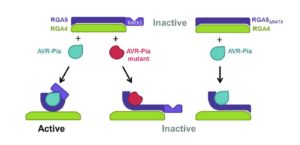 Magnaporthe oryzae is the fungus that causes rice blast disease, which is a serious threat to food security. Ortiz et al. explore the interaction between AVR-Pia, a fungal effector protein, and RGA5, a rice NLR (nucleotide-binding domain and leucine-rich repeat protein) immune receptor protein. RGA5 has a C-terminal domain, RATX1, that acts as an integrated target decoy and that has been shown as important for interaction with AVR-Pia. In this study, the authors use NMR and yeast two-hybrid assays to map the interaction between RGA5 and AVR-Pia. They show that activation of resistance requires AVR-Pia interaction with RGA5 in both central and RATX1 domains, and suggest that this interaction provides resilience to mutations in the effector. Plant Cell 10.1105/tpc.16.00435
Magnaporthe oryzae is the fungus that causes rice blast disease, which is a serious threat to food security. Ortiz et al. explore the interaction between AVR-Pia, a fungal effector protein, and RGA5, a rice NLR (nucleotide-binding domain and leucine-rich repeat protein) immune receptor protein. RGA5 has a C-terminal domain, RATX1, that acts as an integrated target decoy and that has been shown as important for interaction with AVR-Pia. In this study, the authors use NMR and yeast two-hybrid assays to map the interaction between RGA5 and AVR-Pia. They show that activation of resistance requires AVR-Pia interaction with RGA5 in both central and RATX1 domains, and suggest that this interaction provides resilience to mutations in the effector. Plant Cell 10.1105/tpc.16.00435


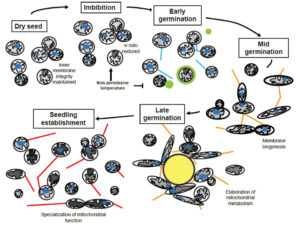 A seed undergoes a dramatic transformation from dried tissues into a mature plant. This change requires energy produced by oxidative metabolism, but dry seeds contain dormant promitochondria that need to be reactivated. Paszkiewicz et al. use bioimaging tools for an in vivo analysis of seed mitochondria biogenesis. Using a fluorescent dye to visualize the membrane potential, they show that seed mitochondria are capable of temperature-dependent oxygen uptake shortly after imbibition at 4°C and 21°C. The authors examine mitochondrial mobility in seeds, and they find mitochondria have limited mobility until perception of germination conditions, despite the presence of F-actin networks. Interestingly, when mitochondria become mobile, they fuse to form a transient tubular structure by the TR (testa rupture) stage. The tubular mitochondrial structure encircles the nucleus of each cell. The authors postulate this transient structure serves to redistribute mtDNA nucleoids among the mitochondria because the mtDNA remains stable during this stage. The redistribution of mtDNA could possibly lead to specialization among mitochondria to facilitate seedling growth. (Summary by
A seed undergoes a dramatic transformation from dried tissues into a mature plant. This change requires energy produced by oxidative metabolism, but dry seeds contain dormant promitochondria that need to be reactivated. Paszkiewicz et al. use bioimaging tools for an in vivo analysis of seed mitochondria biogenesis. Using a fluorescent dye to visualize the membrane potential, they show that seed mitochondria are capable of temperature-dependent oxygen uptake shortly after imbibition at 4°C and 21°C. The authors examine mitochondrial mobility in seeds, and they find mitochondria have limited mobility until perception of germination conditions, despite the presence of F-actin networks. Interestingly, when mitochondria become mobile, they fuse to form a transient tubular structure by the TR (testa rupture) stage. The tubular mitochondrial structure encircles the nucleus of each cell. The authors postulate this transient structure serves to redistribute mtDNA nucleoids among the mitochondria because the mtDNA remains stable during this stage. The redistribution of mtDNA could possibly lead to specialization among mitochondria to facilitate seedling growth. (Summary by 
 Students learn that membrane proteins are inserted into the endoplasmic-reticulum (ER) membrane co-translationally, but this mechanism does not hold for so-called tail-anchored (TA) proteins which carry a single C-terminal membrane spanning domain and insert into the ER membrane post-translationally. The mechanism of TA protein insertion was recently described in yeast as the GET (Guided Entry of Tail-anchored) system, which includes a protein complex that binds to and shields the transmembrane domain, a protein (GET3) that shuttles the protein to the ER, and ER-bound receptors that complete the insertion of the TA protein. Srivistava et al. (Plant Physiol
Students learn that membrane proteins are inserted into the endoplasmic-reticulum (ER) membrane co-translationally, but this mechanism does not hold for so-called tail-anchored (TA) proteins which carry a single C-terminal membrane spanning domain and insert into the ER membrane post-translationally. The mechanism of TA protein insertion was recently described in yeast as the GET (Guided Entry of Tail-anchored) system, which includes a protein complex that binds to and shields the transmembrane domain, a protein (GET3) that shuttles the protein to the ER, and ER-bound receptors that complete the insertion of the TA protein. Srivistava et al. (Plant Physiol 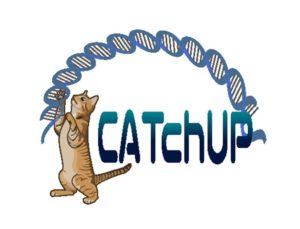 Nakamura et al. have created a searchable database, CATchUP (
Nakamura et al. have created a searchable database, CATchUP (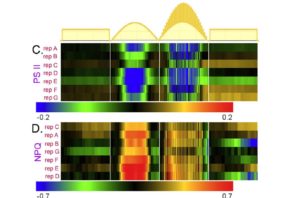 Efficient photosynthesis demands that plants have the capacity to capture photons when they are scarce, but at the same time not suffer damage from capturing more light energy than they are able to assimilate. To accomplish this, leaves need to be able to differentiate between a steady light level and light fluctuations, for example due to the fluttering movements of other leaves. AtRGS1, a receptor-like Regulator of G Signaling protein that is a component of a heterotrimeric G protein complex, is involved in glucose sensing. Liao et al. propose that AtRGS1 contributes to photosynthetic efficiency by serving as a “shadow sensor”. Their experimental results and results of their modeling suggest that glucose, a product of photosynthesis, acts through the G-protein complex (leading to an endocytosis cycle and a GTPase cycle) with a dose-duration reciprocity property, providing plants with the ability to filter out small fluctuations in light intensity or duration and so to adjust their photosynthetic capacity only under appropriate conditions. J. Theor. Biol.
Efficient photosynthesis demands that plants have the capacity to capture photons when they are scarce, but at the same time not suffer damage from capturing more light energy than they are able to assimilate. To accomplish this, leaves need to be able to differentiate between a steady light level and light fluctuations, for example due to the fluttering movements of other leaves. AtRGS1, a receptor-like Regulator of G Signaling protein that is a component of a heterotrimeric G protein complex, is involved in glucose sensing. Liao et al. propose that AtRGS1 contributes to photosynthetic efficiency by serving as a “shadow sensor”. Their experimental results and results of their modeling suggest that glucose, a product of photosynthesis, acts through the G-protein complex (leading to an endocytosis cycle and a GTPase cycle) with a dose-duration reciprocity property, providing plants with the ability to filter out small fluctuations in light intensity or duration and so to adjust their photosynthetic capacity only under appropriate conditions. J. Theor. Biol.  Root architecture and anatomy contribute to water uptake efficiency and plant performance under water-limitation. Prince et al. explored root anatomy in a panel of soybean, and identified metaxylem number as a key trait influencing performance under water-limiting conditions. Increases in metaxylem number were correlated with improved hydraulic conductivity, which enhances water transport. The authors observe that altering the xylem size and number can enhance drought tolerance without incurring a penalty in irrigated conditions, and that selecting for xylem diameter has proven successful in a drought breeding program in wheat. These findings should prove useful for breeding soybeans for water-limited conditions. J. Exp. Bot.
Root architecture and anatomy contribute to water uptake efficiency and plant performance under water-limitation. Prince et al. explored root anatomy in a panel of soybean, and identified metaxylem number as a key trait influencing performance under water-limiting conditions. Increases in metaxylem number were correlated with improved hydraulic conductivity, which enhances water transport. The authors observe that altering the xylem size and number can enhance drought tolerance without incurring a penalty in irrigated conditions, and that selecting for xylem diameter has proven successful in a drought breeding program in wheat. These findings should prove useful for breeding soybeans for water-limited conditions. J. Exp. Bot. 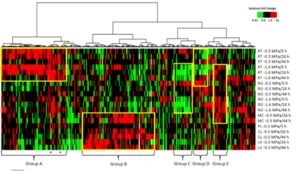 Understanding plant responses to water deficit is crucial for the development of drought-reliance, but complicated by the different ways plant researchers induce water deficit. Starting with the premise that transcription factors are important coordinators of water-deficit responses, Seeve et al. carried out a systematic analysis of maize transcription factor expression in response to defined water deficit conditions, using a vermiculite growth medium that provides reproducible water potential conditions. They identified nearly 400 water-deficit responsive transcription factors, providing a valuable resources for genetic mapping and breeding studies. Plant Cell Environ.
Understanding plant responses to water deficit is crucial for the development of drought-reliance, but complicated by the different ways plant researchers induce water deficit. Starting with the premise that transcription factors are important coordinators of water-deficit responses, Seeve et al. carried out a systematic analysis of maize transcription factor expression in response to defined water deficit conditions, using a vermiculite growth medium that provides reproducible water potential conditions. They identified nearly 400 water-deficit responsive transcription factors, providing a valuable resources for genetic mapping and breeding studies. Plant Cell Environ. 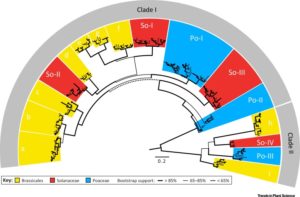 Autophagy is a process of selective membrane trafficking that delivers cargo to the vacuole or plasma membrane for recycling or secretion. ATG8 is a small ubiquitin-like protein that is required for formation of the double-membrane enclosed autophagy vesicle, the autophagosome. The ATG8 gene family has expanded greatly in plants, from one gene in algae to as many as 22 in some angiosperms. Kellner et al. examined the diversity of ATG8 proteins in plants and found that there are distinct ATG8 clades that are unique to particular plant families. The functional significance of this ATG8 diversification remains to be determined, but the authors suggest that different ATG8 isoforms may selectively interact with different protein targets and contribute to different autophagy-mediated processes. Trends Plant Sci.
Autophagy is a process of selective membrane trafficking that delivers cargo to the vacuole or plasma membrane for recycling or secretion. ATG8 is a small ubiquitin-like protein that is required for formation of the double-membrane enclosed autophagy vesicle, the autophagosome. The ATG8 gene family has expanded greatly in plants, from one gene in algae to as many as 22 in some angiosperms. Kellner et al. examined the diversity of ATG8 proteins in plants and found that there are distinct ATG8 clades that are unique to particular plant families. The functional significance of this ATG8 diversification remains to be determined, but the authors suggest that different ATG8 isoforms may selectively interact with different protein targets and contribute to different autophagy-mediated processes. Trends Plant Sci.